Canon EOS R10 advanced manual
Introduction
Canon EOS R10 Menu system
The Shoot Menu (Red Camera Icon)
Page Shoot 1 (SHOOT1)
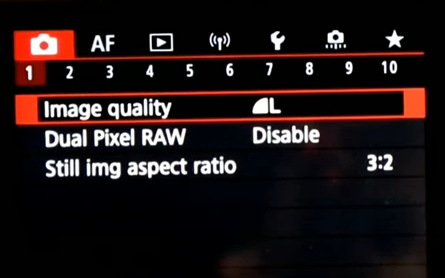
Image quality
You primarily need to decide whether to shoot RAW or JPEG. Raw records all the data from the sensor, Jpeg is basically a much smaller file that has all kinds of information already baked in. Most serious photographers shoot RAW, as this gives you the most flexible file to work with in an application like Adobe Lightroom.
You’ll be able to recover more colour in the highlights of your image, for instance, and pull more detail out of the shadows with a Raw file than with a Jpeg. The only downside are the larger files and the fact that you must develop them later on. RAW file average size of 20.8 MB an JPEG file average size of 10 MB with the EOS R10.
You’ll see that there is also a cRAW option. This is a format that uses lossy compression to reduce file sizes by roughly 40%. This is fine to use, the deterioration is negligible.
If you shoot Jpeg, you can choose between Large (7Mb), Medium (4Mb) or Small (2.8Mb), each with a Fine or Normal setting. I would advise Large and Fine.
Dual Pixel Raw
The dual photodiode construction of the sensor allows it to receive A and B signals, and detect phase differences between the two signals. The focus is retained as a part of the system. The combined A and B image signals are what the sensor gets when you take a picture. Both focusing and shooting with the same sensor can be done with this technology.
There are two images in a single file when shooting dual-resolution images. These two images, one with A and B image data, and one with only A image data. The normal image and the data that can be measured are contained in the dual-resolution files.
Information about the distance from the subject can be determined. Since the images contain two images, they are twice the size of regular pictures. The Digital Photo Professional software can be used to make minor adjustments to the position of maximum sharpness with the depth information stored in the dual-amplified dual-amplified dual-amplified dual-amplified dual-amplified dual-AMP
Still img aspect ratio
This describes how square (1:1) or wide (16:9) your image is. It’s expressed as a figure, like this: width:height (width always comes first).
- Full: the native sensor dimension of the full APS-C mirrorless Canon EOS R10.
- 1:1: a basic square setting.
- 4:3: native resolution of a micro-four-thirds camera .
- 16:9: for a wider perspective.
Page Shoot 2 (SHOOT2)
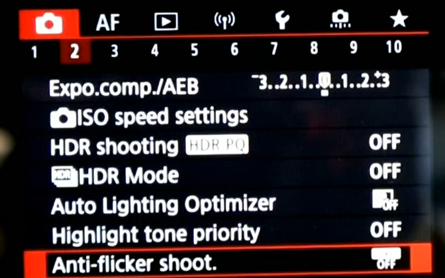
Expo.comp./AEB: Exposure Compensation and Auto Exposure Bracketing.
Exposure compensation: If you believe that your camera is over- or underexposing your images, or you want to do this for creative reasons, you can change the level of exposure by a scale of plus or minus 3 EV.
Auto Exposure Bracketing.: Using the exposure compensation setting, you can capture images at different exposure levels, and then select the optimal image later with a +/- 5 EV scale. These two functions can the be used in combination.
ISO speed settings for photos
ISO speed: can either be set to Automatic or determine an appropriate value for yourself. Say for landscapes when using a tripod this is generally set to what is called base ISO 100. ISO 100 would give you the optimal quality for this sensor, but for many other types of photography you’ll need a higher ISO in order to have a fast enough shutter speed and hence no movement in your images. Leave this on auto for most uses.
ISO Auto: This is used to set the max for Auto, from 00 to the top value of 51200. When raising the ISO value, you are effectively raising the sensitivity of the sensor by boosting the output. This leads to more and more noise with every doubling of power. A Maximum of 12800 is as far as I would go with the Canon EOS R10.
HDR shooting (PQ Setting)
PQ in HDR PQ refers to the gamma curve of the input signal for displaying HDR images. HDR PQ settings enable the camera to produce HDR images conforming to the PQ specification defined in ITU-R BT.2100 and SMPTE ST.2084 (with actual display depending on monitor performance).
- Shots are captured as HEIF or RAW images.
- PQ stands for Perceptual Quantization.
HDR mode
Even in high contrast scenes, you can shoot with clipped shadows and reduced highlights for a high dynamic range of tones. There are still lifes and landscapes that are suitable for shooting. In order to compensate for the loss of detail in dark areas of the image, three images were deliberately captured at different exposures and merged to create an HDR image. The images are captured in a format known as HEIF or JPEG.
Auto Lighting Optimizer
Auto-corrects image brightness and contrast. This only affects Jpeg and not your Raw files, but it can be handy for the Jpeg shooters out there. Have a go and see if you like the effect set to low or standard.
Highlight tone priority
Improves gradation in highlights to avoid over exposure in bright subjects. What the camera does in highlight tone priority is underexpose the image to avoid clipping highlights, then boost the shadows up to give the appearance of a wider dynamic range in the jpegs. It does the same thing you might do when processing raw files, except it just applies it to jpegs. Another great feature to experiment with. Either Off or enabled.
Anti Flicker Shoot.
With anti-flicker shooting, the camera detects the frequency of the light source’s blinking and takes the picture when the flicker’s effect on the exposure or color is detectable.
If you shoot an image with a fast shutter speed under a light source such as fluorescent light, the blinking of the light source causes flicker and the image may be vertically unevenly exposed. If continuous shooting is used under these conditions, uneven exposures or colors across the images may result. With anti-flicker shooting, the camera detects the frequency of the light source’s blinking and takes the picture when the flicker’s effect on the exposure or color is minimal.
Page Shoot 3 (SHOOT3)
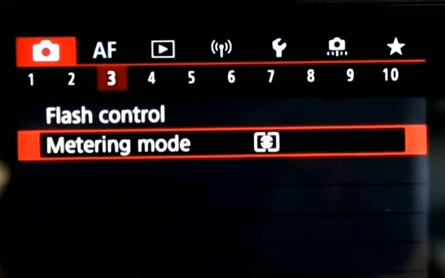
Flash control
Using this menu item, you can adjust flash power. The Flash Control option also enables you to customize as well as control the built-in flash head.
- Flash firing: Normally, this option is set to Enable. If you want to disable the flash, you can choose Disable instead.
- E-TTL II meter: This option enables you to switch from the default flash metering approach, called Evaluative. In this mode, the camera exposes the background using ambient light when possible and then sets the flash power to serve as fill light on the subject. If you instead select the Average option, the flash is used as the primary light source, meaning that the flash power is set to expose the entire scene without relying on ambient light. Typically, this results in a more powerful (and possibly harsh) flash lighting and dark backgrounds.
- Slow synchro: Slow Sync Flash is a function found on many cameras that tells your camera to shoot with both a longer shutter speed as well as firing the flash. This means you get the best of both worlds above and can both get a relatively sharp shot of your main subject as well as get some ambient light from the background and foreground.
- Safety FE: The camera automatically changes the shutter speed or aperture value when the flash fires to avoid overexposing and blowing out the highlights in the scene.
- Flash func. Setting and External flash C.Fn setting: these last 2 options on the Flash Control list relate to how to control external flashes from the EOS R10 itself. This depends very much on what flash you’re using, and you should consult the flash manual in order to set this up.
Metering Mode
There are four methods that can be used to measure the subject’s brightness. It’s usually recommended that evaluative metering is used. In Basic Zone modes, evaluative metering is set automatically. The general-purpose metering mode is suited for backlit subjects. There is a camera that adjusts the exposure to the scene. When there are a lot of brighter lights around the subject, partial metering can be effective. On the screen, there is an indication of the partial metering area. Spot metering can be effective when metering a specific part of the subject. On the screen, there is an indication of the spot metering area. The center of the screen is weighted more heavily with the average of the metering across the screen.
Page Shoot 4 (SHOOT4)
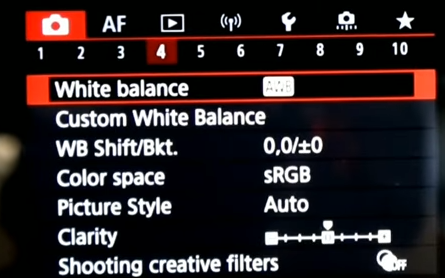
White balance
You have the option to change this setting to AWB W, which is an amazing setting for indoor lighting, Daylight, Shade, cloudy, white fluorescent, and flash.
Custom white balance
This setting brings up compatible images to use. Set the white balance under the same light source that will illuminate your shot.
WB Shift/Bkt.
White balance shift is a setting on the R10 camera that allows a photographer to change the colors of their images in either blue, amber, magenta or green directions. When shooting in mixed lighting conditions, this colour shift can be used to add or remove colour shifts that may occur. Think of flash and daylight, flash and indoor lights, street lights and daylight, and so on. White balance can be changed from -9 to +9 in either blue / amber and green / magenta directions, or combinations of blue/amber and green/magenta shifts. Five mired for each step is how the blue/amber shift is calculated.
Color space
sRGB is the colour space usedis online, and Adobe RGB has a more extended colour profile that mimics the human eye. You might think that the latter is preferable, but unless you print a lot of photos with professional equipment, Adobe RGB is more hassle than its worth since you’ll need to proof every picture you want to use online and convert it to sRGB.
Picture Style
Canon deems the color tones most suitable to each subject, so picture style allows you to take photos with those colors in mind. Standard, Portrait and Landscape are normal preset that include advanced scenarios like Monochrome, Fine Detail, Neutral and Faithful.
Sharpness, Fine detail, Threshold, Contrast, and Saturation are just a few of the adjustments that can be made to these picture styles. There are auto, standard, portait, Landscape, Fine Detail, neutral, Faithful, Monochrome, User Def. 1, 2 and 3.
The low contrast “neutral” picture style provides a histogram on the back of the camera that most-accurately shows me blown highlights and blocked shadows on the camera screen. After capture, I usually change the picture style to the standard.
Clarity
You can adjust the clarity of the image by setting it to the negative end or the positive end.
Shooting creative filters
You are able to shoot with filters applied. The only images that are saved are the ones with the filters applied.
Page Shoot 5 (SHOOT5)
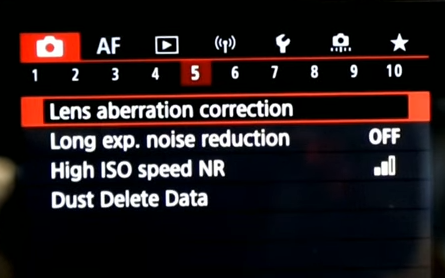
Lens aberration correction
You can make adjustments to drops in peripheral illumination, distortions in the subject, and color blur which occur because of the physical characteristics of the lens or slightly remaining aberration. There is no way to correct the images in JPEG or TIFF. You can either make a single correction to any of the five anomalies, or you can do both at the same time.
It is possible to correct these pheomena:
- Peripheral illumination
- Chromatic aberration (color fringing which occurs in the periphery of an image)
- Color blur (blue or red color blur which sometimes occurs at the edge of the highlighted area of an image)
- Distortions
- Diffraction
Long exp. noise reduction
Turn On noise reduction for exposures of 1 second or longer with the Canon EOS R10. This function takes a second black or dark frame (with the shutter closed) with the identical shutter time of your first photo. The noise in this frame is then subtracted from the original photo. This method is the most reliable type of noise reduction, as the noise is measured specifically at that place and time with the same level of humidity and temperature. All factors that can contribute to noisy images especially in long exposures.
Some photographers however find it annoying to have to wait for this to finish as it doubles the time. You can turn it off and experiment with other types of noise reduction in Lightroom or any other photo editor if you shoot RAW.
High ISO speed NR
You can choose from 3 levels of noise reduction: Standard, High or Low. This function is especially effective when shooting at high ISO speeds.
Multishot: This technique automatically combines four images captured at once to reduce noise. Compared to setting High ISO speed NR to High, this feature minimises loss of image quality while reducing noise. Best technique for Jpeg shooters.
Again, noise reduction is destructive to images details. I prefer to add noise reduction sparingly during post processing.
Dust Delete Data
This function allows you to download your shots to your computer using the canon software. The software will analyse the images and any dust spots that show up on multiple images will be registered. This database is then relayed back to the Canon R that will ignore the pixels with dust on.
I don’t think this is necessary, as periodically wet cleaning yourself or by a professional should be part of your camera cleaning routine anyway.
Page Shoot 6 (SHOOT6)
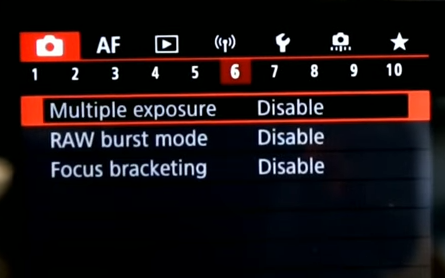
Multiple Exposure
As you shoot multiple exposures (2–9), you can select how the images will be merged into a single image.
- On: Func/Ctrl (Function and control priority) Convenient when shooting multiple exposures gradually as you check the results. During continuous shooting, the continuous shooting speed will decrease greatly.
-
On: ContShtng (Continuous shooting priority) Used for continuous multiple exposures of moving subjects.Continuous shooting is possible without the following operations: menu viewing, image review after capture, image playback, and undo last image.
Multi-expos ctrl setting:
- Additive: The exposure of each single image captured is added cumulatively. Based on the number of exposures setting, set a negative exposure compensation. Follow the basic guide below to set the exposure compensation amount. (Two exposures: -1 stop, three exposures: -1.5 stop, four exposures: -2 stops)
-
Average: Based on the number of exposures setting, negative exposure compensation is set automatically as you shoot multiple exposures. If you shoot multiple exposures of the same scene, the exposure of the subject’s background will be automatically controlled to obtain the standard exposure.
- Bright/Dark: Brightness (or darkness) of the base image and added images is compared at the same position, and bright (or dark) portions are retained. Some overlapping colors may be mixed, depending on the relative brightness (or darkness) of the image.
RAW burst mode
With a 75 per cent crop, photos can be taken at up to 30 frames per second, with the images being stored in a single movie file for neat and easy organisation. The images can be processed and edited with free software. When Pre-Shooting is enabled in the camera’s menu, the R10 captures a small amount of action before the shutter release button is pressed, so you’ll always catch that perfect moment.
Focus Bracketing
When enabled, the focus bracketing feature instructs the camera to take a series of pictures with the lens’ focus distance setting increasing between each image captured until the specified number of images are captured or until infinity focus is reached. The resulting set of images can then be focus stacked during post-processing with the result being an increased depth of field, potentially by a significant amount, while avoiding the softening effects of diffraction caused by very narrow apertures use.
This technique is commonly used in macro photography as the depth of field is typically extremely shallow at very close focus distances. Landscape photographers frequently use this technique to keep entire scenes that include a close foreground subject in focus.
There are four settings used to control the focus bracketing feature.
- Activate Focus Bracketing (Enable/Disable)
- Input number of shots (2 to 999)
- Focus increment (1-10)
- Exposure smoothing (Enable/Disable)
The number of shots instructs the camera to capture up to the specified number of images. I say “up to” because the camera stops taking photographs when infinity focus distance is reached and this may only require a small number of images regardless of the number of shots setting. Use this setting to limit the camera to a shorter focus distance range, or set the number very high to ensure that all distances including infinity are covered.
The focus increment setting is definitely the vaguest on this list. This setting deals with the granularity of the focus distance adjustment between each shot with 1 requesting fine increments and 10 requesting wide increments. Specific distance changes are not able to be input and with the depth of field increasing with distance, a non-specific increment value makes sense. Focus brackets always start with the initial focus distance and proceed toward infinity (the ending distance cannot be directly specified). “The wider the pre-set lens aperture, and the closer the lens is to the subject for the first shot, the finer the focus increments should normally be, and the more Focus Bracketed shots should be dialed-in.”
Exposure smoothing is disabled by default, but when enabled, the camera keeps image brightness consistent through the image set. This feature is primarily useful for compensating for light transmission losses when lenses, especially macro models, are focused at very close distances.
Optional is for the camera to create a new folder on the memory card before the bracketed sequence starts, making it easy to separate a potentially large number of images. Tapping the “Folder +” icon creates a new folder and subsequent images are saved there.
Page Shoot 7 (SHOOT7)
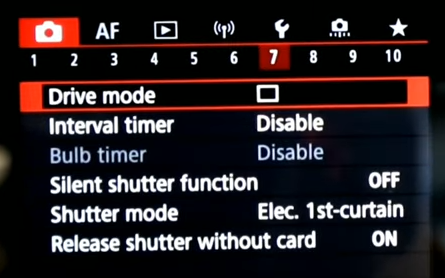
Drive mode
The camera has single and continuous drive modes. You can choose drive mode for the scene or subject.
- Single shooting: When you hold down the shutter button, only one shot will be taken.
- High-speed continuous shooting +: When you hold down the shutter button completely, you can shoot continuously while you hold it down.
- High-speed continuous shooting: You can shoot continuously if you hold the shutter button completely.
- Low-speed continuous shooting: You can shoot continuously at max if you hold down the shutter button completely. Approximately 3.0 shots per second. You hold it down while you hold it down.
- Self-timer: 10 sec.
- Self-timer: 2 sec.
- Self-timer: Continuous
Interval timer
For fully customisable time-lapse photos and movies.
Bulb Timer
This is used for long exposures. Turn this, on, set the exposure timer to your desired setting and then shoot a Bulb exposure. If you want to end the exposure early, just tap the shutter.
Silent shutter function
Shutter release sounds, operating sounds, and firing and illumination of flash and other light sources are all disabled.
Shutter Mode
Mechanical: use the traditional mechanical shutter system.
Elec. 1st-curtain: the EOS R10 will use the electronic shutter for the front, first curtain and the mechanical shutter for the second curtain. Possible problems include only half of a sunstar flare and it can introduce slightly nervous bokeh.
Electronic: uses the full electronic shutter functionality. This is the fastest shutter available but can cause problems like rolling shutter in for instance helicopter blades and can’t be used with flashes.
Release shutter without card
If this is set to ON, you want be able to use the shutter button if there is no SD card inserted in the camera. This is a security feature, so that you won’t start shooting images without actually recording them on an SD card. On the other hand, if you’re just testing the features of the camera, you probably won’t wan’t to store these files, and then you can leave it ON.
Page Shoot 8 (SHOOT8)
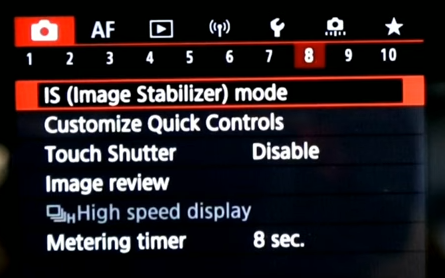
IS (image stabiliser) mode
You can reduce camera shake by using lens based Image stabilization. In order too activate lens IS, set IS mode to on as follows
Custom quick controls
You can customise which Quick Control items appear in the QR menu here, as well as the layout.
Touch shutter
Touch shutter, using the screen as shutter button can be enabled here.
Image review
Image review: You can modify the amount of time the image displays on theLCD monitor after your EOS R10 writes it to the memory card.
High Speed Display
The high speed frame rate is needed for this option. The setting lets the EVF update at a faster rate than the R7 shoots. Doesn’t work with adapted ones. To enable this option, the camera must be set to high speed continuous frame rate.
Metering timer
When you half press the shutter in one of the creative zone modes and then release it, the camera’s meter takes a reading and sets the exposure values. After the amount of time is set by this option, these values time out and disappear. If you want to take a new reading, you have to half press again. 30 seconds from 4 to 16, 30 seconds from 1 to 10, and 30 seconds from 10 to 30.
Page Shoot 9 (SHOOT9)
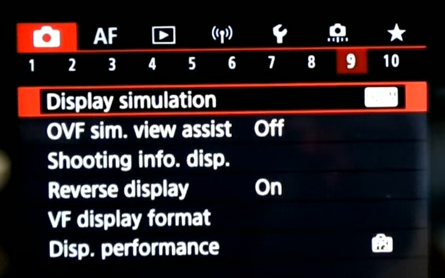
Display simulation
With display simulation, the image brightness and depth of field are more in line with the actual brightness of your shots.
OVF sim. view assist
This function provides a more neutral colour rendition and lifts shadows, similar to a DSLR optical finder.
Shooting info. display
Let’s take a peek at the sub menus here.
Screen info. settings: There are five different screen options in these settings. You can save the data as 3 separate screen types by configuring it on live view. You can either turn on or off the basic shooting info (the data at the top and bottom of the screen), the detailed shooting info (the icons running down the left and right sides), or both at the same time.
The black, non-live view info screen is the last screen that you can use when shooting with the camera, and it has the same style as the fourth screen.
Still within this submenu we have L VF info/toggle settings (3 different EVF choices – one with basic shooting info under the screen, the other two configurable to individually add and combine as desired the vertical detailed shooting info icons, histogram, level gauge].
It’s similar to the previous item in that you can change what you get when you cycle through the styles of VF display whilst shooting.
Then the submenu has Grid display [Off, 3×3, 6×4, 3×3+diag], Histogram disp [Brightness/RGB, Large/Small], Reset. That’s the end of this submenu.
Set to: Screen info. settings: Enable 1 (press Info, disable basic shooting info and enable Electronic level), 3 and 4.
Reverse display
A mirror image can be displayed when you shoot with a camera that has a screen that rotates toward the subject.
VF display format
You can change the way information is presented in the viewfinder.
Display. Performance
The performance parameters can be selected to prioritize in the shooting screen display.
Page Shoot 10 (SHOOT10)
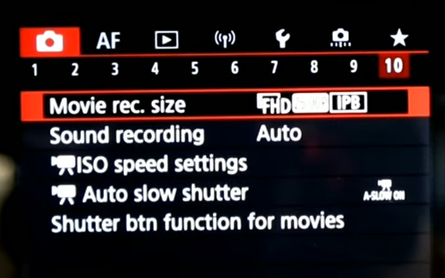
Movie rec Size
Either MPEG-4, H.264 or H.265.
- 4K: 3840 x 2160 16:9, 29.97p, 23.98p
- 4K crop: 3840 x 2160 16:9, 59.94P, 29.97p, 23,98p , 119.9 fps, 59.94 fps, 29.97p, 23.98p
- FHD: 1920 x 1080 16:9 , 119.9 fps, 59.94 fps, 29.97p, 23.98p, 29.97p, 23.98p
Sound Recording
You can record movies while recording sound with the built-in stereo microphone or an external stereo microphone. You can also freely adjust the sound-recording level.
- Auto: The sound-recording level is adjusted automatically. Auto level control will take effect automatically in response to the sound level.
- Manual: You can adjust the sound-recording level as needed. Select Rec. level and press the left/right keys while looking at the level meter to adjust the sound-recording level. Look at the peak hold indicator, and adjust so that the level meter sometimes lights up on the right of the –12 dB mark for the loudest sounds. If it exceeds “0”, the sound will be distorted.
- Disable: Sound will not be recorded.
Wind Filter: Set to Auto to reduce wind noise automatically when there is wind outdoors. Only activated when the camera’s built-in microphone is used. When the wind filter function takes effect, part of the low bass sounds will also be reduced.
Attenuator: Automatically suppresses sound distortion caused by loud noises. Even if Sound rec. is set to Auto or Manual for recording, sound distortion may still result if there is a very loud sound. In this case, setting it to Enable is recommended.
Using a microphone:
Normally, the camera’s built-in microphone records in stereo.
If an external microphone equipped with a miniature stereo plug (3.5 mm diameter) is connected to the camera’s external microphone IN terminal, the external microphone will be given the priority. Using the Directional Stereo Microphone DM-E1 is recommended.
Using headphones:
By connecting commercially available headphones with a 3.5 mm mini plug to the headphone terminal, you can listen to the sound as movies are recorded.
ISO Speed settings for movies
ISO speed: can either be set to Automatic or determine an appropriate value for yourself.
ISO Auto: This is used to set the max for Auto, from 400 to the top value of 204800. When raising the ISO value, you are effectively raising the sensitivity of the sensor by boosting the output. This leads to more and more noise with every doubling of power.
Auto slow shutter
You can choose whether to shoot movies that are brighter and less affected by image noise than when set to Disable by automatically slowing the shutter speed under low light.
- Disable: You can choose whether to shoot movies that are brighter and less affected by image noise than when set to Disable by automatically slowing the shutter speed under low light.
- Enable: Enables you to shoot brighter movies, less affected by image noise, than when set to Disable by automatically reducing the shutter speed to 1/30 sec. (NTSC) or 1/25 sec. (PAL) under low light.
Shutter btn function for movies
When the EOS R10 is set to Movie mode, you can set the shutter button to start and stop movie recording instead of the Rec button.
The Autofocus Menu (AF)
AF Page 1
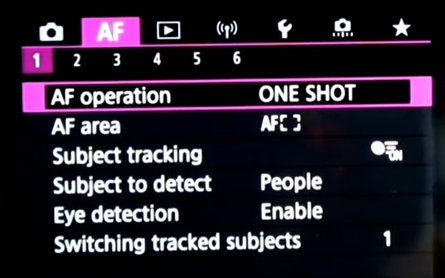 `
`
AF operation
One Shot: for Still Subjects. When you press the shutter button halfway, the camera will focus only once.
- When focus is achieved, the dot inside the AF point achieving focus lights up briefly in red, and the focus confirmation light in the viewfinder will also light up.
- With evaluative metering, the exposure setting will be set at the same time focus is achieved.
- While you hold down the shutter button halfway, the focus will be locked. You can then recompose the shot if desired.
Servo: This AF operation is for moving subjects when the focusing distance keeps changing. While you hold down the shutter button halfway, the subject will be focused continuously.
- The exposure is set at the moment the picture is taken.
- When the AF point selection is automatic, the camera first uses the center AF point to focus. During autofocusing, if the subject moves away from the center AF point, focus tracking continues as long as the subject is covered by another AF point.
Manual focus: use the focus ring of the lens to focus manually.
AF method
- Spot AF: The focus of the camera is in a smaller area.
- 1-point AF: The camera uses a single point to focus on something.
- Expand AF area: Focus with the AF Point indicated by the red dot and AF area indicated in blue. Effective for moving subjects, including moving cars, bicyclists, or people, which are difficult to focus on. Focusing on your preferred subject is easier than with Flexible Zone AF. When Servo AF is used, first you will focus using an AF point.
- Expand AF area: Around: Focuses on one point and the surrounding area, which makes it easier to focus on moving subjects than on Expand area.
- Flexible Zone AF 1: The square Zone AF frame is set by default.
- Flexible Zone AF 2: If this is the case, a rectangular Zone AF frame is set.
- Flexible Zone AF 3: Zone AF frame is set by default. With Flexible Zone AF 1–3, you can freely set the size of the Zone AF frame . Uses auto selection AF in Zone AF frames to cover a larger area than Expand AF area, which makes focusing easier than with 1-point AF/Expand AF area and effective for moving subjects. Focusing areas are determined not only based on the nearest subject but also based on a variety of other conditions such as faces (of people or animals), vehicles, subject motion, and subject distance. Pressing the shutter button halfway displays a box over AF points in focus.
- Whole area AF: Uses auto selection AF in a whole-area AF frame to cover a larger area than Flexible Zone AF, which makes focusing easier than with 1-point AF/Expand AF area/Flexible Zone AF and effective for moving subjects. A variety of other conditions such as faces, vehicles, subject motion, and subject distance are used to determine focusing areas.
Subject to detect
You can choose between People, animals or Vehicles or none (the camera will attempt to auto detect the subject).
Eye Detection
You can turn on eye focus here, the camera will attempt to focus on the eyes of people or animals .
Continuous AF
Enable or disable continuous AF where the camera constantly tries to acquire focus, even without pressing the shutter. Turn this Off.
Movie Servo AF
With this function enabled, the camera focuses on the subject continuously during movie recording.
Touch & drag AF settings
Touch & Drag AF basically means that you can drag the desired autofocus point to anywhere on the screen. This is much faster than any other method to do this.
You can select the active touch area: Whole panel, Right, Left, Top Right, Btm Right, Top Left, Btm Left. I have it set to the Bottom Left since this allows you to look through the EVF and change the focus point easily at the same time.
AF Page 2
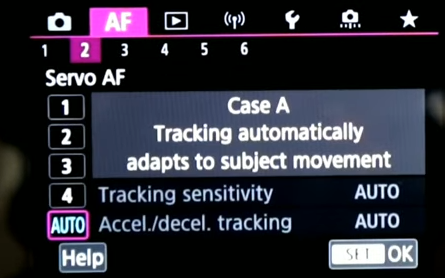
Case 1: Versatile multi purpose setting
The setting is suited for moving subjects in general. It is suitable for a wide range of subjects and scenes.
Select Case 2 to case 4 if you want non- subjects moving across points, subjects that suddenly appear or change speed, or subjects that are elusive.
Case 2: Continue to Track Subjects, Ignoring Possible Obstacles
Setting to focus on the subject even if non- subjects move across the same points. If you prefer focus, don’t switch to non-subjects or the background.
Case 3: Instantly Focus on Subjects Suddenly Entering AF Points
It was necessary to focus on a series of subjects at different distances. If a new subject appears in front of the target subject, focus will switch to it. When you want to always focus on the closest topic, it’s also effective.
Case 4: For Subjects That Accelerate or Decelerate Quickly
Even if subjects suddenly change speed, the setting is to keep tracking and focusing on them. It’s good for subjects who have sudden movements, sudden stops, or sudden acceleration.
AF Page 3
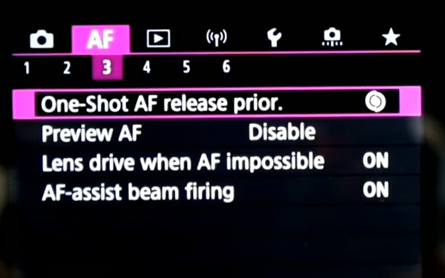
One-Shot AF release prior.
Effective when you want to achieve focus before capturing the shot. You can set the AF operation characteristics and shutter-release timing during continuous shooting after the first shot with AI Servo AF. Equal priority is given to focusing and continuous shooting speed.
Preview AF
The function keeps subjects focused. When you press the shutter button, the camera is ready to focus.
Lens Drive when AF impossible
This setting can help your photos take off as quickly as possible by helping to reduce the time it takes to achieve focus when shooting at longer focal lengths, which is especially useful with super-telephoto lenses.
AF Assist Beam Firing
When using a flash that has an assist beam, you can turn it off or on.
AF Page 4
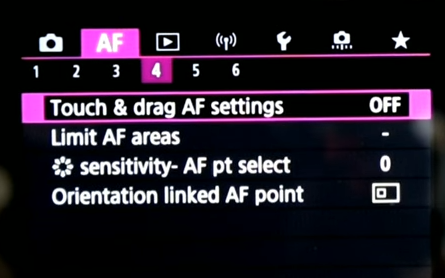
Touch & Drag AF Settings
As you look through the viewfinder, you can move the Zone AF frame by tapping or dragging on the screen.
Limit AF areas
You’ll find a list of all AF methods here, you can select and deselect which ones you use or don’t use, so that there’s less clutter in the AF Method Menu.
Sensitivity- AF pt select
The sensitivity of the Multi- Controller joystick AF point selection can be adjusted to a user’s desire with the EOS R10.
Orientation linked AF point
Depending on whether you hold the camera in a landscape orientation, portrait with the grip up or portrait with the grip down orientation, you can choose from up to three different methods for selecting the right point in the photo. You can choose whichever method you want to use for that orientation by simply rotating the camera. This is useful for a lot of situations. At a sport game, you can choose to use the central point when shooting in a landscape format but the middle top point for focusing on a face when shooting in a portrait mode. You can choose an alternate or favourite point that you can switch to immediately by using one of the buttons on the R10. An alternate set of settings that can be recalled using a single button press can also be selected with this customisation. When photographing a running race you may find this useful. You may want to use one method for the start of the race and another for the end as the runners dip for the line.
AF Page 5
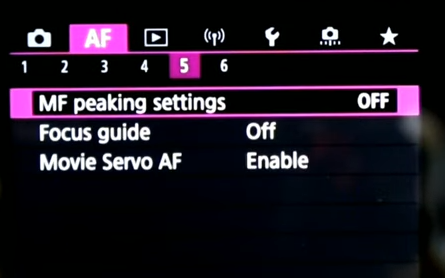
MF peaking settings
Peaking is a focussing aide when the camera is set to manual focus. The in-focus area will have a type of coloured noise superimposed onto scene in the EVF or on the screen. This is of course not stored, it’s merely an aide that helps you determine where your focus lies and if your subject will be in focus. Very handy feature, I have it set to the Color red and Level High.
Focus Guide
Setting Focus guide to On provides a visual guide that shows which direction to adjust focus and the extent of adjustment needed. The guide frame is displayed near any eyes that are detected for the main subject when for instance Face +Tracking is used.
Movie Servo AF
With this function enabled, the camera focuses on the subject continuously during movie recording.
AF Page 6
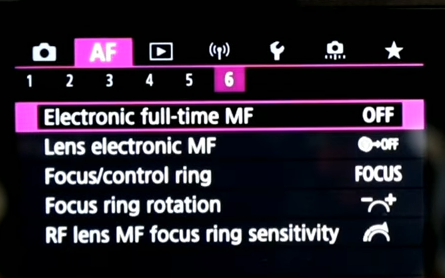
Electronic full-time MF
When certain lens are attached, the operation of manual focus adjustment using the electronic focusing ring is changeable. You can check out the Canon website for compatible lens.
Lens electronic MF
If you have a lens with electronic manual focusing, you can specify how the focus adjustment is done.
Focusing ring rotation
The rotation of the focusing ring of the RF lens can be reversed to adjust settings.
RF lenses MF focus ring sensitivity
It is possible to set the sensitivity of the RF lens focusing ring.
Playback Menu (blue playback icon)
Page Play 1 settings (PLAY1)
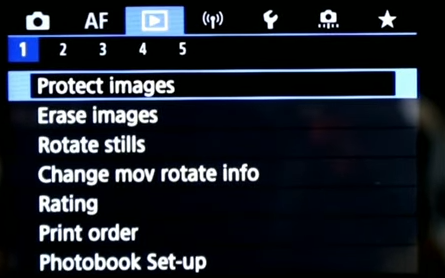
Protect images
You can select how to protect and unprotect an image from deletion on the R10. Once an image is protected, it cannot be erased by the camera’s erase function. To erase a protected image, you must first cancel the protection. If you erase all the images, only the protected images will remain. This is convenient when you want to erase unnecessary images all at once.
You can choose to Select images, Select range, All images in folder, unprotect all images in folder, All images on card or unprotect all images on card.
Erase images
Select and erase images by selecting a range or All images in folder orAll images on card.
Rotate stills
Vertical images are rotated automatically so they are displayed vertically on the camera’s LCD monitor and personal computer instead of horizontally. The setting of this feature can be changed.
- Immediately after image capture, the vertical image will not be automatically rotated for the image review.
- If the vertical image is taken while the camera is pointed up or down, the image might not rotate automatically for playback.
- If the vertical image is not automatically rotated on the personal computer screen, it means the software you are using is unable to rotate the image.
Change mov rotate info
You can manually change movie orientation information (which determines which side is up)
Rating
You can rate images on a scale of 1–5.
Print order
You can connect the camera to a printer via Wi-Fi to print your images directly. This setting takes you to the selection screen where you can select a single image, multiple images for printing and the general set up. See the tutorial below on how to connect to a smartphone, it is the same procedure to connect to a printer
Photobook Set-up
This function is useful for ordering photobooks online and for printing photobooks on a printer.
When you select images to use in photobooks (up to 998 images) and use EOS Utility (provided software) to transfer them to a computer, the selected images will be copied into a dedicated folder. This function is useful for ordering photobooks online and for printing photobooks on a printer.
Page Play 2 settings (PLAY2)
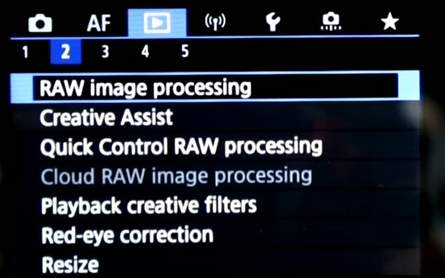
RAW image processing (RAW/DPRAW)
Being able to perform RAW image post-processing right after shooting on a camera is a function that comes in very handy.
These settings are available on the Canon R:
- Brightness adjustment: EV-1, EV-2/3, EV-1/3, EV±0, EV+1/3, EV+2/3, EV+1
- White balance: WB: Shot settings, Auto, Day Light, Shade, Cloudy, Tungsten light, White fluorescent light, Flash, Colour temperature
- Picture Style: Picture Style: Shot settings, Auto, Standard, Portrait, Landscape, Fine Detail, Neutral, Faithful, Monochrome, User Def. 1, User Def. 2, User Def. 3
- Auto Lighting Optimizer: Disable, Low, Standard, High
- High ISO speed Noise Reduction: Disable, Low, Standard, High
- Image quality: write small, medium and large jpeg files in fine or standard resolution.
- Peripheral illumination correction: Enable/Disable
- Chromatic aberration: Enable/Disable
- Diffraction correction: Enable/Disable
Creative assist
You can apply your preferred effects to the images and then save them as JPEGs.
Quick control RAW processing
You can use the camera to process RAW pictures. The images are the same as when captured, so you can adjust the processing conditions to create as many images as you need.
Cloud RAW processing
RAW images can be uploaded to image.canon to be processed into jpeg images. You can adjust the processing conditions to create as many HEIFs as you need, because the RAW images remain the same as when captured.
Playback creative filters
Grainy B/W, Soft focus, Fish-eye effect, Art bold effect, Water painting effect, Toy camera effect, and Miniature effect are some of the effects that can be applied to an image and saved as a separate image.
Red-eye correction
The setting automatically corrects portions of images that have red-eye. The image can be saved as a separate file.
Resize
It’s possible to resize a JPEG or HEIF image to reduce the pixel count and save it as a new image.
Page Play 3 settings (PLAY3)
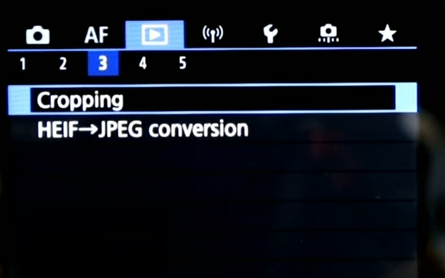
Cropping
Complementary to the other in-camera RAW processing feature, you can crop your image or multiple images here freely or according to preset dimensions.
HEIFF to jpeg
The EOS R10 capable of recording (HDR-PQ Shooting) still images in HEIF file format. These 10-bit files feature broader tonal range and bit depth in-comparison to 8-bit JPEG image, allowing for even more highlight detail to be captured, when displayed on HDR-compliant monitors or via HDR printing workflow. you can convert these HEIF files to jpeg here.
Page Play 4 settings (PLAY4)
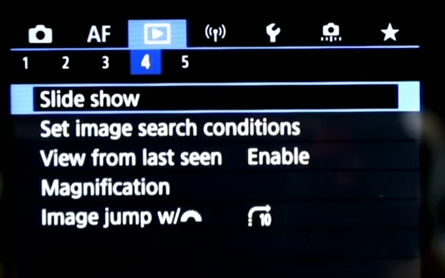
Slide show
You can setup and start an in-camera slideshow here.
Set image search conditions
You’ll find lots of factors to choose here, I honestly don’t know why this was implemented and never use it.
View from last seen
Resume from previous playback.
Magnificatn (apx)
you can set the starting magnification and initial position for the magnified view.
-
1x (no magnification): The image will not be magnified. The magnified view will start with the single-image display.
- 2x, 4x, 8x, 10x (magnify from center): he magnified view will start at the image center at the selected magnification.
-
Actual size (from selected point): The recorded image’s pixels will be displayed at approx. 100%. The magnified view will start at the AF point that achieved focus. If the photo was taken with manual focus, the magnified view will start at the image center.
-
Same as last magnification (from center): The magnification will be the same as the last time you exited the magnified view. The magnified view starts from the image center.
Set to “Actual size (from selected pt)”. It allows one button press during playback to zoom deeply into the image.
Image jump w/dial
This setting selects how much of the jump your image library will tale when you turn the dial.
You can select one by one, jump 10, jump by specified number, by date, by folder, display movies only, stills only, protected only or display by image rating.
Page Play 5 settings (PLAY5)
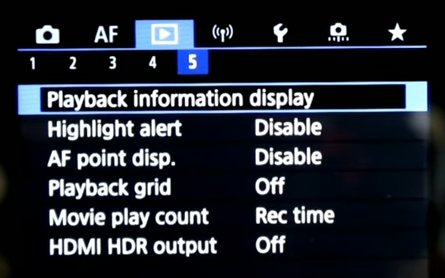
Playback information display
You can enable up to 9 individual screens – all except the first, which is the basic shooting info overlay, allow the histogram to be specified as brightness or RGB, and in some cases, both. Enable to avoid too many playback options.
Highlight alert
The Highlight Alert setting will show you where the overexposed areas in your images are located. The image preview will blink in areas that are completely white and have no detail.
Set to Enable, it causes overexposed pixels to blink.
AF point disp.
This setting either shows or hides the number of AF points on screen and in your EVF.
Playback Grid
Sets the number of images or previews in the grid when you select Playback.
Set to 3×3, it helps with checking alignment.
Movie play count
Set the movie play count to either recording time or Time Code for sync.
HDMI HDR output.
You can choose to turn on HDR in the HDMI output.
Wifi Menu
Wifi page 1
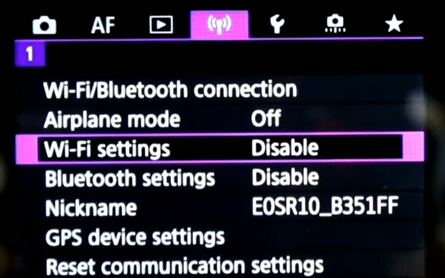
Wi-Fi/Bluetooth connection
On this screen, you can change the wireless communication function settings.
Wi-Fi settings
- You can set whether to Enable or Disable the wireless communication function.
- Password: Set to None to allow a Wi-Fi connection to be established without a password (except when connecting to an access point via Wi-Fi).
- Connection history: You can set whether to Show or Hide the history of the Wi-Fi connected devices.
- Auto send images to computer: With the dedicated software Image Transfer Utility 2, you can send images on the camera to a computer automatically.
- Send to smartphone after shot: Your shots can be sent to a smartphone automatically.
- MAC address: You can check the MAC address of the camera.
Wi-Fi function:
- Communicate with smartphones
- Remote control (EOS Utility)
- Print from Wi-Fi printer
- Send images to Web service
Bluetooth function: Displays the screen on which you can set or check the Bluetooth functions.
Send images to smartphone: While the camera is connected to a smartphone, use this function to send images stored in the camera to the smartphone.
Nickname: You can change the nickname using the virtual keyboard.
Clear settings: Clear all wireless communication settings.
Airplane mode
Airplane mode disables all wireless communication. If you’re not using it, best to turn it on all the time. This also saves battery life.
Wi-Fi settings
You can enable or disable the WiFi functionality here.
Bluetooth Settings
You can enable or disable the Bluetooth functionality here.
Nickname
You can change the default name of your camera here. This is the name that you’ll see on your phone when trying to connect with your EOS R10.
GPS Device settings
When you’re shooting while connected to a compatible smart device via Bluetooth, EOS R10 can collect GPS data and automatically add it to your images using the Canon Camera Connect app. It makes identifying locations easy and provides a useful editing feature for when you’re back home.
Image transfer
With the dedicated software Image Transfer Utility 2, you can send images on the camera to a computer automatically. You’ll need to setup the Wifi connection first.
Reset communication settings
Reset all WiFi and communication settings to the factory defaults.
Set Up Menu (Spanner, gear icon)
Set Up Menu Page 1 (SET UP1)
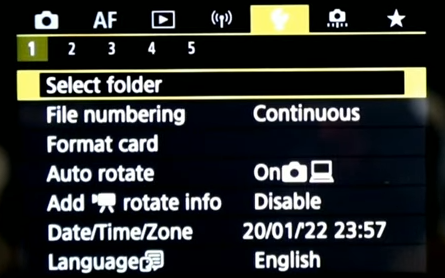
Select folder
f you insert a CF card and SD card, you can select the recording method and select which card to use for recording and playing back images.
- Standard: Images will be recorded to the card selected with Record/play.
- Auto switch card: Same as with the Standard setting, but if the card becomes full, the camera will automatically switch to the other card to record images. When the camera switches to the other card, a new folder will be created automatically.
- Rec. separately: You can set the image-recording quality for each card. Each image is recorded to the CF and SD cards at the image recording quality you have set.
- Rec. to multiple: Each image is recorded to the CF and SD cards simultaneously at the same image size. You can also select RAW+JPEG.
When separately is set, the maximum burst will decrease greatly When Rec. separately or to multiple is set, the image will be recorded under the same file number to the CF and SD cards. Also, the LCD panel will display the number of possible shots of the card having the lower number. If one of the cards becomes full, Card full will be displayed and shooting will be disabled. If this happens, either replace the card or set the recording method to Standard or Auto switch card and select the card with space remaining to continue shooting
File numbering
You can set the file numbering for each new shot to Continuous or Auto Reset/Manual Reset. Continuous will consecutively number your photos. Auto reset will reset the numbering every time an SD card is inserted, and Manual reset will reset the numbering once.
File name
Choose your own image naming scheme here.
Format card
You should format your card in-camera every time you insert a memory card when starting a new session. This to make sure that there won’t be any writing errors. Remember that formatting will erase all the images on the card, and won’t even be recoverable if you choose the low level format option.
Auto rotate
Auto rotate automatically rotates your images that are shot in portrait mode to fit the screen size. You can turn this on or off and decide whether this will behaviour will also apply to images imported to your PC using the canon software .
Add video rotate info
add rotation info to video files or not.
Date/Time/Zone
Select the date, time and worldwilde zone of your Canon EOS R10.
Language
Select the language of the camera.
Set Up Menu Page 2 (SET UP2)
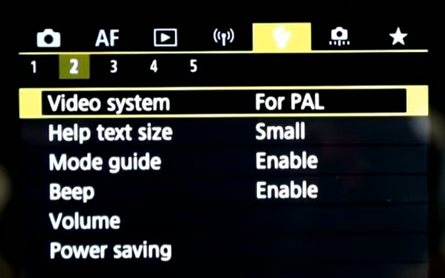
Video system
select either PAL or NTSC video systems depending on your area.
Help Text Size
Select the size of the optional menu help messages between small, medium or large.
Beep
You can either enable or disable the beep when you engage the shutter as well as when you touch the screen.
Set to disable as you don’t to hear you beeping camera setting changes or focus confirmation.
Volume
Set the volume of the headphone outputs of the Canon EOS R10.
Power saving
The power will shut off in the following circumstances. Press the power button again to restore power.
Set Up Menu Page 3 (SET UP3)
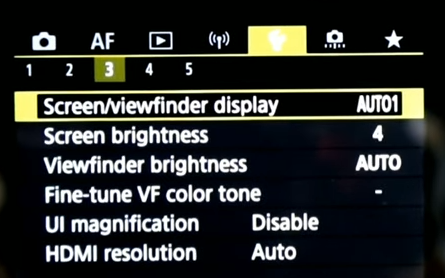
Screen/viewfinder display
You can select to display or hide the operating state of the R10 on the LCD screen/viewfinder . The display also appears on a TV connected to the camcera.
Screen brightness
Change the brightness of the LED screen here.
Viewfinder brightness
Change the brightness of the EVF here.
Fine-Tune VF color tone
A perfect EVF color tone is important to many photographers. Besides the coarse adjustments made with the menu above, you can further tweak the EVF color tone here.
Ui magnification
You can magnify menu screens by double-tapping with two fingers. Double-tap again to restore the original display size.
Magnification is also available on the Quick Control screen in viewfinder shooting, the Custom Quick Control screen, and the electronic level screen.
HDMI resolution
You can choose either Auto where the camera will decide automatically what type of device it’s connected too, 1080p or 4K.
Set Up Menu Page 4 (SET UP4)
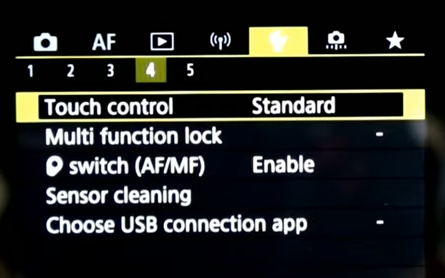
Touch control
You can turn on or off the touch sensitive screen on the back of your Canon EOS R10. Standard/Sensitive/Disable.
Multi function lock
If you find yourself regularly changing settings on the camera accidentally while moving around, then making use of the multi-function lock can avoid issues when you come to shoot in a fast-paced environment. The lock switch below the quick command dial can be used to lock the main dial, the multi-controller or the quick control dial – simply select which you would like to lock through the custom function in Group 2 Disp./Operation. When you come to change a setting, you may see L displayed in the viewfinder and on the top LCD panel. If this happens, you will be unable to change the setting because the multi-function lock is set. Simply flick the switch and the camera will return to normal.
switch (AF/MF)
The camera’s focus mode switch can be configured when an RF lens with a focus mode switch is attached.
Sensor cleaning
You should set this to Auto cleaning. This will send a charge through your sensor every time you turn it off, dislodging any dust particles that might be on the sensor. You should also make a habit of regularly cleaning the señor cage with a simple air blower.
If you prefer to only periodically clean the sensor, you can use the ‘clean now’ function to immediately do this procedure.
Choose USB connection app
By connecting the camera to a smartphone or computer with a connecting cable, you can transfer the images or import them to a smartphone or computer.
Set Up Menu Page 5 (SET UP5)
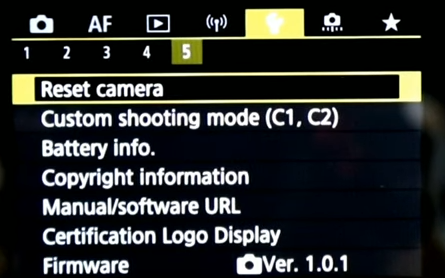
Reset camera
As a last resort in case of problems, you can fully reset the R10 to factory settings here.
Custom Shooting Mode (C1-C3)
You can register current camera settings, such as the shooting mode, menu functions, and Custom Function settings, as Custom shooting modes under the Mode Dial’s C1, C2, and C3 positions.
Battery info
You can check the remaining capacity, shutter count and recharge performance of your battery here.
Copyright information
Insert your own copyright information here. This will be written to every image you take.
Certification logo display
You can find the url to the Canon software manual here. But mine is better…
Certification Logo Display
A bunch of certification logos. You officially have my permission to ignore this :).
Firmware
You can check the firmware revision number here.
Custom Function Menu
C. Fn1: Exposure Settings
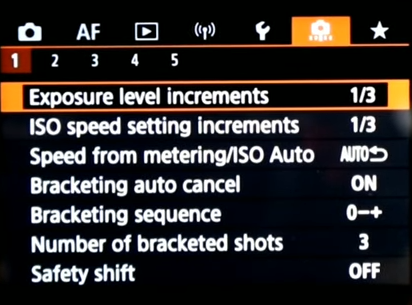
Exposure level increments Sets 1/2-stop increments for the shutter speed, aperture, exposure compensation, AEB, flash exposure compensation, etc. This is effective when you prefer to control the exposure in less fine increments than 1/3-stop.
ISO speed setting increments You can change the manual ISO speed setting increments to 1-stop or 1/3 stop.
Bracketing auto cancel ON: Enable When you set the power switch to 2, the AEB and white balance bracketing settings will be canceled. AEB will also be canceled when the flash is ready to fire or if you switch to movie shooting. OFF: Disable The AEB and white balance bracketing settings will not be canceled even if you set the power switch to <2>. (If the flash is ready to fire or if you switch to movie shooting, AEB will be canceled temporarily, but the AEB range will be retained.
Bracketing sequence The AEB shooting sequence and white balance bracketing sequence can be changed from the starting point zero plus/minus 1.
Number of bracketed shots The number of shots taken with AEB and white balance bracketing can be changed from the default, 3 shots, to 2, 5, or 7 shots.
Safety shift OFF: Disable Tv/Av: Shutter speed/Aperture. This takes effect in the shutter-priority AE (s) and aperture priority AE (f) modes. If the subject brightness changes and the standard exposure cannot be obtained within the autoexposure range, the camera will automatically change the manually-selected setting to obtain a standard exposure. ISO: ISO speed. This works in the Program AE (d), shutter-priority AE (s), and aperture-priority AE (f) modes. If the subject brightness changes and the standard exposure cannot be obtained within the autoexposure range, the camera will automatically change the manually set ISO speed to obtain a standard exposure.
C. Fn2: Exposure Settings
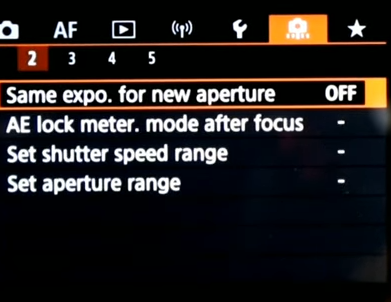
Same exposure for new aperture
If the ‘a mode’ (manual exposure shooting) is set and the ISO speed is set manually (other than Auto ISO or H (12800) is set), the maximum aperture’s f/number may change to a higher number (smaller aperture) if you do any of the following: 1. Change the lens, 2. Attach or detach an Extender, or 3. Use a zoom lens whose maximum aperture f/number changes. If you then shoot at the exposure setting as is, the image will be underexposed by the amount the maximum aperture f/number changes to a higher number. However, by changing the ISO speed or shutter speed (Tv) automatically, you can obtain the same exposure that would be obtained before you did 1, 2, or 3. OFF: Disable Automatic changes in settings to maintain the specified exposure will not be applied. The ISO speed, shutter speed, and aperture already set will be used for shooting. If you do 1, 2, or 3 and the maximum aperture f/number increases, adjust the ISO speed and shutter speed before you shoot. ISO: ISO speed If you do 1, 2, or 3, the ISO speed will automatically increase to compensate for the amount that the maximum aperture f/number increases by. The same exposure that would be obtained before you did 1, 2, or 3 is thereby obtained. Tv: Shutter speed If you do 1, 2, or 3, a slower shutter speed will automatically be set to compensate for the amount that the maximum aperture f/number increases by. The same exposure that would be obtained before you did 1, 2, or 3 is thereby obtained.
AE lock meter. mode after focus
If you check “spot” metering for AE locked after focus, then I can lock the exposure when the shutter button is pressed halfway to focus. Then you can recompose the image using AE (perhaps evaluative) and Auto ISO. The new compostion will now register new AE and Auto ISO.
Set shutter speed range
You can set the shutter speed range. In the <s> <a> modes, you can set the shutter speed manually within the shutter speed range that you have set. In the <d> <f> modes, the shutter speed will be set automatically within the shutter speed range that you have set.
- Highest speed: You can set it from 1/8000 sec. to 15 sec.
- Lowest speed: You can set it from 30 sec. to 1/4000 sec
Set aperture range
You can set the aperture range. In the <f> <a> <F> modes, you can set the aperture manually within the aperture range that you have set. In the <d> <s> modes, the aperture will be set automatically within the aperture range that you have set.
- Min. aperture (Max. f/): You can set it from f/91 to f/1.4.
- Max. aperture (Min. f/): You can set it from f/1.0 to f/64.
C. Fn3: Operation Settings
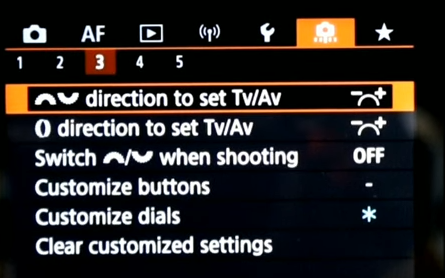
Dial direction during Tv/Av
Dial turning direction when setting the shutter speed and aperture can be reversed.
direction to set AV/TV
The control ring rotation function can also be reversed here.
Switch dial when shooting
Switch the function of the rotary dial when shooting.
Customize buttons
Within the Customize buttons category, the EOS R10 lets users change the function of 14 different camera controls for still-image shooting; if the camera is set to a video recording mode, that drops to 12 different buttons.
A few general points here, before we dive into the details. First, while the number of potential changes users can apply to most of the buttons are much more extensive than we’ve seen on previous Canon EOS DSLRs, each control has a specific, factory-set list of possible functions you can apply. And, these do vary in some cases, from one control to another. For instance, there are 25 possible choices to modify the rear AF point select button when you shoot still images, but 41 for the adjacent AE Lock button.
Furthermore, it’s not possible (as of late 2018) to add or delete items from the factory-set customization list for each control — if a feature isn’t listed on the menu for customizing a particular button, it can’t be added to that button’s capabilities.
Even with this, the list of possible changes is far more extensive than we’ve seen in previous Canon EOS DSLRs. To take just one example, the AF-ON button on the top-of-the-line EOS-1D X Mark II digital SLR camera gives the user 9 possible ways to customize it; the same AF-ON button on the EOS R10 provides 41 possible choices.
And, the EOS R10’s customization changes, depending on if the camera is in a still-image shooting mode, or switched over to a video shooting mode. Set to video, you lose the ability to customize the function of the Movie Start button (on top of the camera, with the red dot icon), and the shutter button, via the Customize buttons menu. (However, in a video shooting mode, there are settings in the 4th Set-up Menu screen for Shutter Button function, allowing users to modify how it operates for a half-press and full press during video shooting.)
And, in a video shooting mode, the possible functions you can apply to a particular button sometimes change from what’s available in a still-image shooting mode. This is absolutely normal, and not a sign of any malfunction.
Customize dials
Change the operation of the Main Dial, Quick Control Dial, and Control Ring on Canon’s RF lenses (and on the optional Control Ring Lens Mount Adapter EF-EOS R10)
Clear customised settings
Clear all your custom settings.
C. Fn4: Operation Settings
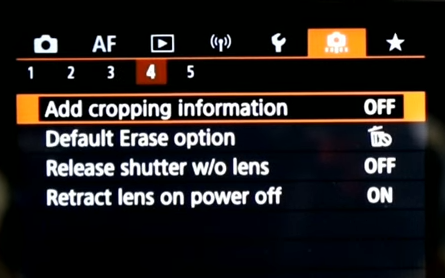
Add cropping information
Add the cropping information to the image info.
Default erase option
You can specify which options will be your default when erasing images. This way, you don’t have to go through the default process when selecting images for erasing.
Release shutter w/o lens
You’ll be able to engage the shutter without the Canon EOS R10 detecting a lens. This is a handy option if you’re using third party manual lenses without electronic contacts. When using these lenses, the camera is unaware of the fact that a lens is connected, and the shutter would otherwise not work.
Retract lens on power off
If a powered zoom lens is attached to the EOS R10, setting this function to ON would cause the lens to retract when the camera is powered off.
C. Fn5: Other Settings
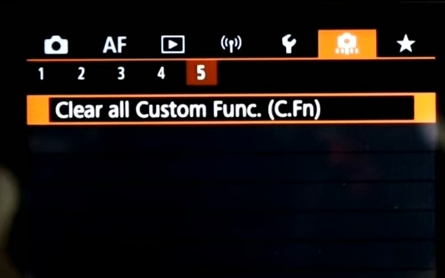
Clear all Custom Func. (C.Fn)
Clears all the user custom functions saved in the Custom functions Menu and resets them to the factory defaults.
My menu (green)
MY MENU1
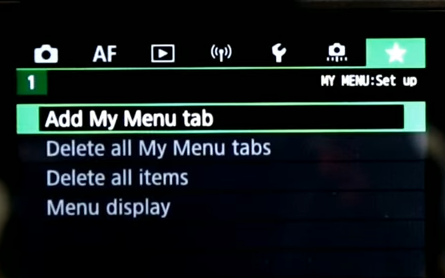
My Menu allows you to build your own menus. You can add all your most used Menu functions to this page like Format for instance. Adding favourite functions to this menu means that you’ll be able to access them quicker than having to browse through the entire Menu system.
Conclusion
The EOS R10 is a fantastic mirrorless camera, and as you might have noticed there are many features hidden inside the Menu system. Even when coming from another Canon APS-C camera the Canon EOS R10 is somewhat different because this is a mirrorless system with it’s own strengths and weaknesses.
An EVF like this might take some time to get used too for instance, but the addition of features like Eye AF should make your job as a photographer easier on the other. A great way to get to know the Canon EOS R10 is to read this thorough menu run-through alongside your camera, set it up and do some testing of your own.
If you have any questions, feel free to ask them in the comment section below. Happy shooting!

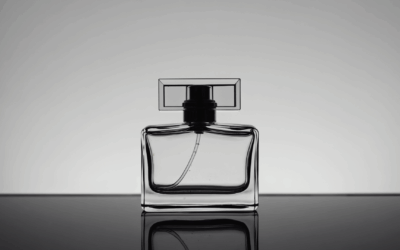
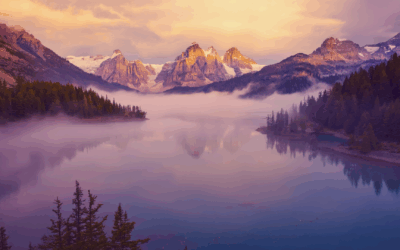
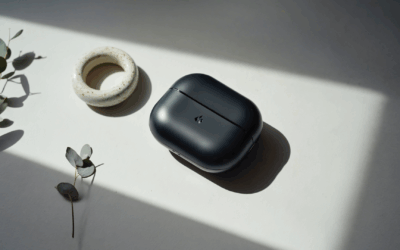
0 Comments